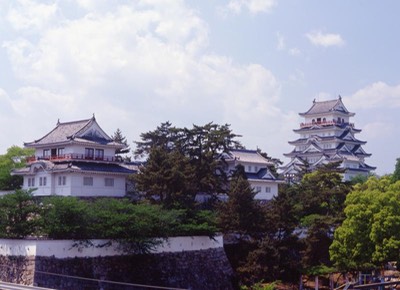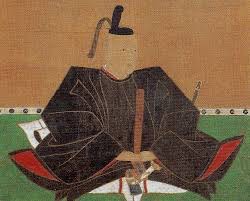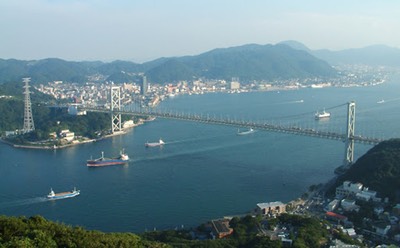It is believed that during the Kan’ei era (1624–29) Musashi visited Mizuno Katsunari (1564–1651) at his headquarters of Fukuyama castle. During his visit he stayed at the yashiki of Nakayama Shigemori, one of Mizunari’s chief retainers, who is said to have held a banquet in honor of his guest.
Musashi’s visit to Fukuyama is immortalized in a large stone that had become the swordsman's favorite place to sit while sojourning in his host’s garden. Though Shigemori’s yashiki has long since been destroyed, the stone on which Musashi used to sit has been moved to the precincts of the Bingo Go-kuni shrine, situated on the castle ground’s norther perimeter, where it graces the temple grounds under the name of Musashi Meisō Ishi (Musashi’s Meditative Stone).
It is not clear how exactly how Katsunari and Musashi first met. The first document to suggest a relationship—if not outright friendship—between Musashi and Katsunari is a recently discovered copy of Musashi’s Heidō kagami addressed to none other than Katsunari himself. The document in question is dated “an auspicious day,” in the twelfth month of the thirteenth year of Keichō (January 1609). This means that Musashi had already met and befriended Katsunari by the time he was only twenty-five, when he was still living in Edo developing and promoting his Enmei school of swordsmanship.
What is certain is that Musashi served under Katsunari during the summer siege of Osaka castle. Musashi was the fourth among a group of ten mounted warriors attached to none other than “Sakushū-sama”, the honorary name of Katsunari’s son, Katsushige. It is quite possible that Musashi’s immediate commander in that battle was Nakayama Shigemori. That would explain why the roll call (Osaka ojin no otomo) on which Musashi appears was rediscovered in 1984 among the possessions of a certain Nakayama Fumio (Nagoya), a direct descendant of Nakayama Shigemori (Shōgen), who was one of Katsunari’s chief retainers.
In reward for his contribution to Ieyasu’s Osaka campaigns Mitsunari was initially promoted to the Kōriyama han, a fief of sixty thousand koku in Yamato province. Given Katsunari’s huge contribution, the promotion was already frowned upon by his contemporaries, not least by himself, as he had expected a fief of at least two-hudred thousand koku. Yet it had been precisely his reckless valor, which had vexed Ieyasu (who could ill afford to lose such a valuable ally), that had cost Katsunari a more lofty promotion.
Katsunari’s pride was somewhat restored in 1619, when Ieyasu’s son, Hidetada, promoted him to the Fukuyama fief in the province of Bingo. At the time, the fief was still only worth a hundred-thousand koku (another one-thousand were added in 1626), but it did control the western part of the Inland Sea, making it—as well as Katsunari’s appointment—of strategic importance to the bakufu. In 1622, to better police the sea, he therefore abandoned his more inland headquarters of Kannabe castle, for the newly built Fukuyama castle at the mouth of the Ashida River.
Any queries of remarks? Launch or join a discussion at our new FORUM


